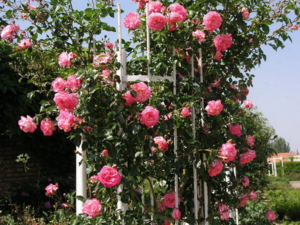You can transplant a garden beauty both in spring and in autumn, however, in areas with cold winters, spring is the most preferable time for planting a plant in open ground. This especially applies to standard roses - planted in the spring, they will have time to prepare the root system over the summer and will not die in winter frosts.
Features of spring rose transplant
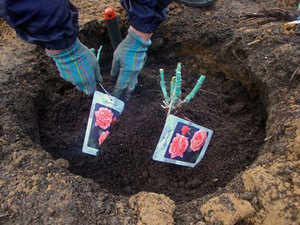 Usually, the planting time falls in April, when the cold has already receded, and the first buds have not yet woken up and the plant is ready to spend its vitality on confident rooting in a new place.
Usually, the planting time falls in April, when the cold has already receded, and the first buds have not yet woken up and the plant is ready to spend its vitality on confident rooting in a new place.
However, to prepare for this responsible procedure, the gardener it is necessary in advance, three weeks to a month before the scheduled date for transplanting the rose bush.
Transplant equipment:
- tools (shovel, pitchfork, pruner, bucket, watering can);
- rags (burlap, natural fabric);
- spruce branches or screen for shading from the sun.
Fertilizers:
- Rotten manure (cow, horse or chicken), compost.
- Mineral fertilizers.
- Ash or lime, bone meal or egg shells.
- Nitrogen fertilizers.
The first thing to worry about before transplanting a flower princess is choosing a suitable place for her new residence. Loving sunny warmth and open space, the rose feels great on the southern slopes, protected from the cold wind.
At the same time, she does not like the proximity of buildings that create stagnant air. The rose is picky about other plants located in the neighborhood, which must be taken into account when choosing a site for transplantation.
Site preparation
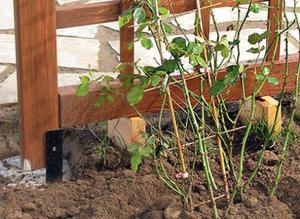 The accumulation of melt water in spring and stagnant rainwater are detrimental to the rose, therefore, when preparing a place for transplanting, you need take care of good drainage and raise the site if the groundwater is close to the soil surface.
The accumulation of melt water in spring and stagnant rainwater are detrimental to the rose, therefore, when preparing a place for transplanting, you need take care of good drainage and raise the site if the groundwater is close to the soil surface.
The soil before transplanting the rose is prepared in advance. A layer of loose, organic-rich soil with a weakly acidic reaction is created by no less than 40 cm.
To do this, mix the soil and well-rotted manure or compost in equal parts, add a little ash or lime and bone meal. As a result, the acidity level should be at a pH level of 6.5-7.
Pit preparation method
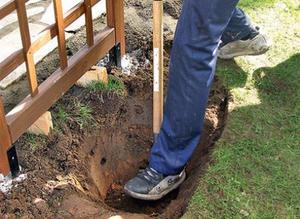 The size of the pit or trench is made with a margin so that a lump of earth can freely fit into it, with which the rose will be transplanted. You can navigate by the crown of the plant - its projection onto the ground approximately corresponds to the area occupied by the root system.
The size of the pit or trench is made with a margin so that a lump of earth can freely fit into it, with which the rose will be transplanted. You can navigate by the crown of the plant - its projection onto the ground approximately corresponds to the area occupied by the root system.
Pit size is generally considered sufficient 60 cm wide and 45 cm deep... If not a pit, but a trench is being prepared, then it is better to place it from north to south - this will improve lighting for future plantings.
On sandy soils, the bottom of the pit is filled with a 7 cm layer of clay so that the soil dries out less. For clayey areas, on the contrary, the bottom is covered with a large sand and gravel, preventing waterlogging of the future residence of the rose bush. The prepared pit should be allowed to settle for 2-3 weeks, after which the intended rose bush can be transplanted into it.
Preparing a bush for transplanting
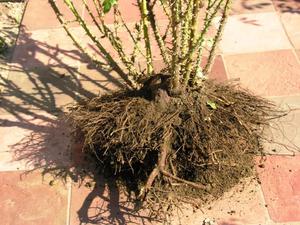 Noticing the width of the crown of the rose chosen for transplantation, it is tied tightly so that the branches of the bush do not interfere with the work.To form a dense clod of earth around the roots, the plant is watered abundantly.
Noticing the width of the crown of the rose chosen for transplantation, it is tied tightly so that the branches of the bush do not interfere with the work.To form a dense clod of earth around the roots, the plant is watered abundantly.
When the water is absorbed and compacts the soil, you can start digging in the bush around the previously designated root area. Grafted roses have a central taproot that goes deep into the ground.
Such a root you just have to chop off... For unvaccinated bushes, the superficial location of the root system is characteristic, so this problem will not arise with them.
When a trench is dug around the bush with a depth of 30–40 cm, you can remove the plant and lay it, together with an earthen clod, on a previously prepared rag.
If the bush and the corresponding clod of earth are very large, tying with a rag can be done as you dig a trench, carefully laying a cloth around the bush and, having fixed the ground well with matter, remove the rose from the ground.
If the place where the rose is to be transplanted is far away and the transportation of the bush will take a long time, the fabric holding the earthen lump must moisturize regularly by spraying.
Transfer
 So, the rose bush has been delivered to the place of its new residence and is ready for transplantation. The fabric that keeps the earth from shedding can be removed, or it can be left, if there is a fear that this procedure may damage the integrity of the earthen coma.
So, the rose bush has been delivered to the place of its new residence and is ready for transplantation. The fabric that keeps the earth from shedding can be removed, or it can be left, if there is a fear that this procedure may damage the integrity of the earthen coma.
A pit prepared for plant transplantation, should be well spilled, and, until the water is absorbed, install a rose bush in it, trying to maintain the same depth at which the rose grew in the same place. At this stage, you can add a root growth stimulant to the water.
In several stages, the rose is covered with earth and watered so that voids do not form. Having tamped the soil around the new settler apply mineral fertilizers, stepping back 15 cm from the shoots, and loosen the ground under the bush, but shallowly, no more than 10 cm. After that, the rose is watered again and the ground around it is mulched.
Experienced gardeners recommendations
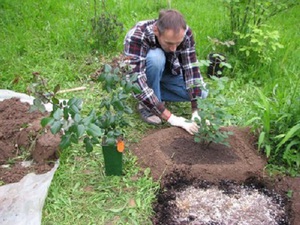 If, when transplanting a rose, it was not possible to save an earthen lump and it still crumbled, you do not need to panic, the plant will not die, only the transplantation procedure will change.
If, when transplanting a rose, it was not possible to save an earthen lump and it still crumbled, you do not need to panic, the plant will not die, only the transplantation procedure will change.
Since the roots of the rose are bare, it's time to take the opportunity to examine them and cut off the damaged ones. For two hours, you can soak the roots in a solution that stimulates their growth, an agent suitable for this variety.
At the bottom of the pit prepared for transplantation, an earthen mound is poured, over which the roots of the rose are distributed so that the root neck of the grafted rose is 3-5 cm below ground level.
The bush is grafted towards the south, for a self-rooted rose - flush with the ground, and for a climbing one, you will have to deepen the root collar by 10-15 cm.
By alternately adding water and earth, the plant is tamped, and when the hole is completely filled, they are trampled down so that the soil adheres more tightly to the roots of the rose and does not contain air voids. Further, land water, loosen, fertilize and mulch in the same way as they do when a rose is transplanted along with a clod of earth.
The branches of the rose, tied to make it more convenient to transplant the bush, should now be freed and brought in accordance with the root system, which inevitably received damage during manipulations.
Shoots are cut at a distance of about 25-30 cm from the root neck, making a cut above the outer bud. Cut out all the broken and unripe stems remove dried leaves... When pruning and forming a bush, they are guided by the features inherent in this particular variety of roses and recommendations for them.
Post-transplant care
 The first time after transplanting, about a month, it is advisable to shade the plant, covering it from direct sunlight. To protect the rose weakened after transplanting from the invasion of aphids, it is sprayed solution of copper sulfate and some kind of pest control.
The first time after transplanting, about a month, it is advisable to shade the plant, covering it from direct sunlight. To protect the rose weakened after transplanting from the invasion of aphids, it is sprayed solution of copper sulfate and some kind of pest control.
The first three to five days after transplanting, the plant is not disturbed, they allow it to recover. After these days a rose begin to water regularly, and after 10-12 days nitrogen fertilizers are applied.
In the first year after transplanting, if the rose bush is still weak, you will have to sacrifice flowering and remove all buds, in order to give the plant how to get stronger and develop the root system. It is recommended to transplant the rose again no earlier than three years later.
